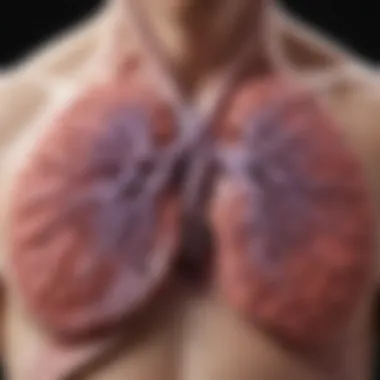Understanding Sarcoidosis: A Comprehensive Exploration


Intro
Sarcoidosis is a complex and often perplexing condition that manifests through the formation of granulomas, predominantly affecting the lungs and lymphatic system. While it might seem straightforward at first glance, the disease presents a multifaceted challenge. This complexity arises from its varied clinical symptoms, diverse demographics, and an incomplete understanding of its underlying causes.
Clarifying the intricacies of sarcoidosis is essential. Not only does this knowledge assist healthcare professionals in diagnosis and treatment, but it also empowers researchers to delve deeper into the mechanisms behind this uncommon condition. Understanding sarcoidosis has implications for better patient management, targeted therapies, and identifying factors that contribute to its progression or resolution.
In this article, we will systematically explore the pathophysiology of sarcoidosis, profile its clinical manifestations, review current diagnostic approaches, and discuss treatment modalities. Additionally, we shall touch upon future directions that research might take in this field, outlining critical areas that require further examination.
The journey through sarcoidosis can be overwhelming, which is why this comprehensive exploration aims to demystify the subject. With a blend of empirical findings and clinical insights, we aim to provide a resource that engages students, researchers, and healthcare professionals alike.
Overview of Sarcoidosis
The overview of sarcoidosis is crucial for understanding this complex and multifaceted disease. This section lays the groundwork for exploring the various dimensions of sarcoidosis, from its definition to its epidemiology. By comprehensively examining these initial elements, readers can better appreciate the intricacies involved in this condition.
Importance of Overview
Providing an overview allows for clarity on what sarcoidosis is and why it matters. This disease disproportionately affects certain populations, making knowledge of its characteristics essential for healthcare professionals. Furthermore, as the research continues to evolve, it is imperative to understand historical context and current trends in epidemiology to grasp potential future directions in study and treatment.
Definition and Historical Context
Sarcoidosis is defined as a systemic granulomatous disease that primarily affects the lungs and lymphoreticular system. The disease is marked by the formation of small clusters of inflammatory cells, known as granulomas. Historically, the first descriptions of sarcoidosis date back to the late 19th century. Since then, various research studies have tried to unravel its complexities. Over time, key insights into the disease's etiology, affected populations, and clinical implications have emerged.
Epidemiology
Epidemiological data highlights the variable prevalence of sarcoidosis across different demographics. The condition most frequently affects individuals in their 20s to 40s, with a notable higher incidence in African American populations compared to Caucasians. Global studies have indicated wide variance in prevalence rates, with surveys in the United States suggesting that about 10 to 20 out of every 100,000 people are affected. Males seem to be more often diagnosed than females, although this gap is closing in recent years.
Understanding these epidemiological trends is vital. It helps identify at-risk populations and guides future preventive strategies. The complexities of sarcoidosis emphasize the need for ongoing research to discover its causative factors and optimal treatment pathways.
"Understanding the overview of sarcoidosis is pivotal. It shapes how we approach diagnosis and treatment while revealing the gaps in current knowledge that require further investigation."
Engaging with this comprehensive overview will pave the way for deeper exploration into the pathophysiology, clinical manifestations, diagnosis, treatment, and advancements in sarcoidosis research.
Pathophysiology
In understanding sarcoidosis, the pathophysiology is crucial. This term refers to the biological processes and mechanisms that underlie the disease. Grasping the pathophysiology helps in comprehending how sarcoidosis affects the body, its progression, and how various interventions can be developed. It also sheds light on why certain individuals may experience more severe symptoms and outcomes, while others present with mild manifestations.
Immune Response Mechanisms
Sarcoidosis is primarily an immunological condition. The immune system plays a key role in its onset and progression. When an individual is exposed to certain antigens, an aberrant immune response occurs. This response involves T lymphocytes, which are a type of white blood cell critical in immune function. They mistakenly attack the body’s own tissues, causing chronic inflammation.
As the immune response continues, it triggers the release of various cytokines. These signaling molecules facilitate communication between cells and exacerbate the inflammatory process. Over time, this sustained immune activation leads to the formation of granulomas, which are clusters of immune cells. The exact trigger for this immune response remains unclear, but possible factors include environmental exposures, infectious agents, and genetic susceptibility.
Granuloma Formation
The formation of granulomas is a hallmark of sarcoidosis. Granulomas are small, organized collections of immune cells that form as a response to inflammation. This process begins when activated macrophages surround the antigens that the immune system is trying to eliminate. The clustering of these immune cells often leads to tissue injury and dysfunction.
The granuloma's structure is complex. It usually contains lymphocytes, macrophages, and multinucleated giant cells. As a result, the affected organ can become impaired. For instance, in pulmonary sarcoidosis, these granulomas can disrupt normal lung function, leading to symptoms such as shortness of breath and persistent cough.
The presence of granulomas in sarcoidosis is not just a sign of inflammation but indicates a maladaptive immune response.


Over time, some granulomas may resolve spontaneously, while others can lead to fibrosis, complicating the patient's prognosis. This variability in granuloma behavior contributes to the different clinical outcomes observed in sarcoidosis patients.
Understanding both the immune response mechanisms and granuloma formation provides insight into the underlying processes of sarcoidosis. It aids in developing more targeted treatment approaches and furthering research to optimize management strategies for affected individuals.
Clinical Manifestations
Clinical manifestations of sarcoidosis play a crucial role in understanding the disease's complexity. This section highlights how various symptoms inform healthcare professionals about the disease progression and influence treatment decisions. Recognizing these manifestations is essential in guiding appropriate diagnostic measures and tailoring individual treatment strategies.
Pulmonary Symptoms
Pulmonary symptoms are often the most prominent features of sarcoidosis. About 90% of individuals with sarcoidosis experience respiratory symptoms at some point. Common pulmonary manifestations include:
- Cough: A persistent, dry cough is frequently reported. It may result from lung involvement and can significantly affect quality of life.
- Dyspnea: This is a feeling of shortness of breath that can vary in intensity. It can emerge silently, leading to advanced pulmonary impairment before being noticed.
- Chest Pain: Patients may experience discomfort, which can accompany coughing or breathing.
Radiographic evidence typically reveals bilateral hilar lymphadenopathy or interstitial lung disease. This connection aids clinicians in identifying sarcoidosis early. The chronic nature of pulmonary symptoms often necessitates careful monitoring for potential complications, such as pulmonary fibrosis.
Systemic Involvement
Sarcoidosis is not limited to the lungs. Its systemic involvement can manifest in various organs, making it a multi-organ disease. Some notable systemic symptoms include:
- Fatigue: Chronic fatigue affects many patients and can impact daily functioning.
- Skin Lesions: Erythema nodosum and lupus pernio are specific skin manifestations associated with sarcoidosis. These provide visual clues to a physician regarding disease activity.
- Ocular Symptoms: Uveitis and other eye disorders can occur, affecting vision and necessitating ophthalmological evaluation.
- Lymphadenopathy: Enlargement of lymph nodes, particularly in the thoracic region and other areas, is common.
The systemic nature of the disease complicates diagnosis, as symptoms can mimic other conditions. This further emphasizes the need for a thorough clinical evaluation.
Rare Presentations
Certain patients may exhibit rare presentations of sarcoidosis, which can pose challenges for diagnosis. These atypical manifestations can include:
- Neurological Symptoms: Sarcoidosis can affect the central or peripheral nervous system, leading to seizures or neuropathies.
- Cardiac Sarcoidosis: Arrhythmias and heart block can occur, with possible implications for sudden cardiac events.
- Endocrine Involvement: Often less recognized, sarcoidosis can affect the pituitary gland, leading to hormonal imbalances.
Rare presentations emphasize the need for vigilance and awareness among healthcare providers. They must consider sarcoidosis in differential diagnoses even when classic symptoms are absent, as these rare manifestations can be debilitating or life-threatening.
Understanding the diversity of clinical manifestations is vital. Early recognition may improve management outcomes and enhance patient quality of life.
Diagnosis
Diagnosis of sarcoidosis is a crucial step in managing the disease effectively. A timely and accurate diagnosis can significantly affect treatment options and overall patient outcomes. Given the multifactorial nature of sarcoidosis, it is essential to distinguish it from other conditions with similar manifestations. This section explores various components of diagnosis, including clinical evaluations, imaging techniques, histological examinations, and considerations for differential diagnosis.
Clinical Evaluation
A comprehensive clinical evaluation is the first step in diagnosing sarcoidosis. This usually begins with a thorough patient history and physical examination. During the medical history, physicians look for symptoms such as persistent cough, fatigue, and weight loss, common in sarcoidosis. Understanding the patient’s background, including environmental exposures and family history, can offer significant clues.
Physical examinations can reveal signs like lymphadenopathy and skin lesions. The clinician may check for eye involvement, which can occur in some patients. Additionally, routine laboratory tests may be ordered to assess organ function and look for systemic inflammation, potentially providing further insights into the diagnosis. However, clinical evaluations alone are often insufficient to confirm sarcoidosis.
Imaging Techniques
Imaging plays a vital role in diagnosing sarcoidosis. Chest X-rays are typically the first-line imaging tool. They can reveal characteristic changes, such as hilar lymphadenopathy and pulmonary changes. In certain cases, high-resolution computed tomography (HRCT) scans may be necessary for more detailed imagery to evaluate pulmonary involvement.
These imaging techniques help clinicians assess the extent of the disease. They are crucial in detecting any complications or associated conditions that may alter treatment strategies. It’s important to note that imaging alone cannot confirm sarcoidosis and must be complemented by other diagnostic methods.


Histological Examination
Histological examination is essential to confirm a diagnosis of sarcoidosis. This involves the microscopic analysis of tissue samples, which can be obtained through methods such as bronchoscopy or biopsy. The key finding in sarcoidosis is non-caseating granulomas, which are clusters of immune cells indicative of an exaggerated immune response.
Identifying these granulomas helps differentiate sarcoidosis from other diseases that may present similarly, such as tuberculosis or lymphoma. A definitive diagnosis often relies on the correlation between histological findings and clinical presentation.
Differential Diagnosis
Differential diagnosis is a critical component of the diagnostic process for sarcoidosis. It is essential to distinguish sarcoidosis from other conditions that can mimic its symptoms and imaging characteristics. Several disorders, including tuberculosis, lymphoma, and autoimmune diseases like lupus, share common features with sarcoidosis.
Physicians must consider these potential mimickers during the diagnostic process. This requires a combination of clinical judgment, imaging, and laboratory findings. In some cases, refining the differential diagnosis may require cooperation with specialists, particularly in managing rare presentations.
By understanding the complexity of sarcoidosis and its various manifestations, healthcare professionals can better navigate the intricacies of diagnosis. Clinical evaluations, alongside imaging and histological assessments, form a comprehensive approach to diagnosing this multifaceted disease.
“An accurate diagnosis is the foundation of effective management, laying the groundwork for tailored treatment strategies.”
In summary, each diagnostic element in the evaluation of sarcoidosis contributes to a clearer understanding of the condition, guiding effective management strategies and improving patient outcomes.
Treatment Approaches
Understanding the treatment approaches for sarcoidosis is crucial for managing the condition effectively. It determines not only the quality of life of patients but also their long-term health outcomes. Given the heterogeneous nature of sarcoidosis, treatment strategies must be tailored to individual patient circumstances. Commonly, therapies focus on alleviating symptoms and limiting complications. The selection of treatment often depends on the severity of symptoms, the organs involved, and the overall health of the patient.
Additionally, awareness of both pharmacological and non-pharmacological strategies can empower patients and clinicians alike to engage in informed decision-making.
Pharmacological Interventions
Pharmacological interventions play a key role in the treatment of sarcoidosis, especially in cases where the disease is severe or symptomatic. The primary aim of these medications is to reduce inflammation associated with granuloma formation. Corticosteroids, such as prednisone, are often prescribed as the first line of treatment. These drugs are effective in diminishing inflammation, allowing the body to manage the excess immune response. However, long-term use of corticosteroids is associated with potential side effects, including bone loss, weight gain, and increased risk of infections.
In addition to corticosteroids, other immunosuppressants may be utilized, such as methotrexate, azathioprine, and mycophenolate mofetil. These alternatives can help to control inflammation while potentially minimizing the adverse effects linked to steroids.
It’s important to monitor patients regularly to assess the effectiveness of the treatment and detect any side effects early. The choice of medication can also vary based on the organs affected by the disease, with specific drugs preferred for pulmonary, cardiac, or skin involvement.
Non-Pharmacological Strategies
In parallel with pharmacological interventions, non-pharmacological strategies also hold significant importance in the management of sarcoidosis. These approaches are designed to enhance the overall wellbeing of patients and can often complement traditional therapies effectively. Non-drug methods include lifestyle modifications, rehabilitation programs, and psychological support.
Lifestyle modifications are fundamental. Patients are often encouraged to maintain a balanced diet, engage in regular exercise, and refrain from smoking. Good nutrition supports general health and may mitigate some symptoms. Furthermore, physical activity can improve lung capacity and overall resilience.
Pulmonary rehabilitation programs provide structured exercise training along with education about the disease. This approach aims to enhance physical endurance and help patients manage their symptoms more effectively. Engaging in activities that promote relaxation, such as yoga or meditation, can also alleviate stress and improve quality of life.
Psychological support is another essential aspect of non-pharmacological treatment. Dealing with a chronic illness like sarcoidosis can lead to emotional challenges. Therefore, counseling and support groups can offer necessary guidance and a sense of community.
Prognosis and Management
The prognosis and management of sarcoidosis is a critical aspect of understanding this disease. Effective management can significantly impact a patient's quality of life and long-term outcomes. Sarcoidosis is heterogeneous in nature, which means that its presentation and progression can vary widely among individuals. Therefore, a tailored approach to prognosis and management is essential.
Long-term Outcomes
Long-term outcomes for sarcoidosis patients depend on various factors including the extent of organ involvement, the patient's age, and the presence of comorbid conditions. While many patients experience spontaneous remission, some may develop chronic disease that can lead to significant morbidity. In cases where the lungs are severely impacted, there is potential for pulmonary fibrosis, which can result in long-term respiratory issues.


Studies indicate that about 50% of individuals with sarcoidosis may achieve complete resolution within three years. Approximately 25% experience a milder form that resolves slowly. However, a notable percentage of patients will suffer from chronic symptoms or long-term complications. Monitoring lung function tests can provide valuable insights into pulmonary involvement and assist in predicting outcomes for individual patients.
"Understanding the variability in long-term outcomes is crucial for both patients and caregivers. Each case of sarcoidosis is unique."
Monitoring and Follow-Up
Monitoring and follow-up care for sarcoidosis is paramount in ensuring the best possible outcomes. Careful observation allows healthcare providers to identify changes in disease status and adjust treatment plans accordingly. Regular check-ups should include assessments of lung function, follow-up imaging, and clinical evaluations based on symptoms reported by the patient.
The multidisciplinary approach is often beneficial. Cardiologists, dermatologists, and rheumatologists, may be involved when other organs are affected. Timely interventions can help manage complications like granulomatous inflammation in the heart or skin.
Considerations for follow-up include:
- Frequency of visits: Regular appointments should be arranged every three to six months for monitoring purposes. This ensures any progression of the disease is addressed promptly.
- Symptom assessment: Patients should report any new or worsening symptoms immediately. This approach can facilitate early interventions and enhance management strategies.
- Psychosocial support: Addressing mental health and emotional well-being is critical. Support groups and counseling can assist patients dealing with the uncertainty surrounding their condition.
In summary, a strategic plan in both prognosis and management can greatly enhance the understanding and treatment of sarcoidosis. Continuing research and better understanding of this complex disease will undoubtedly pave the way for improved patient outcomes.
Recent Advances in Research
Research into sarcoidosis has evolved significantly over the last decade, uncovering critical insights into the mechanisms underlying this complex disease. Advances in our understanding of the genetic and environmental factors associated with sarcoidosis have opened new avenues for targeted prevention and treatment strategies. Additionally, novel therapeutic approaches are reshaping how clinicians manage the disease and improve patient outcomes.
Genetic and Environmental Factors
Researchers are examining the interplay between genetic predisposition and environmental triggers in the pathogenesis of sarcoidosis. Studies have identified specific gene variants associated with the disease, such as in the HLA (human leukocyte antigen) region. Patients with certain HLA alleles are found to have an increased risk of developing sarcoidosis, particularly among certain populations, including Africans and Caucasians.
Environmental factors like exposure to organic dust, infectious agents, and pollutants have also been linked to the onset of sarcoidosis. For example, occupational exposures in industries such as healthcare or construction may elevate the risk for susceptible individuals. Understanding these factors is crucial for developing preventive measures and identifying high-risk groups.
"The identification of genetic markers may help predict who is at risk and allow for earlier intervention, potentially mitigating disease severity."
Continued research aims to uncover how these genetic and environmental interactions contribute to granuloma formation, which is the hallmark of sarcoidosis. This knowledge could facilitate the development of new diagnostic and therapeutic options.
Novel Therapeutic Approaches
The landscape of sarcoidosis treatment is shifting, with recent research yielding innovative strategies. While corticosteroids remain the standard treatment, there is a growing interest in alternative therapies that can minimize long-term steroid use and its adverse effects. One of the most promising areas is the utilization of biologic agents.
Drugs like infliximab and adalimumab, which target specific components of the immune system, are being investigated for their efficacy in severe or refractory cases of sarcoidosis. These agents can help inhibit the inflammatory response, potentially reducing granuloma formation and improving lung function. Clinical trials are underway, exploring their safety and effectiveness compared to traditional treatments.
Additionally, researchers are looking at precision medicine approaches, tailoring therapies based on individual genetic profiles and disease characteristics. Such approaches may enhance treatment efficacy and minimize side effects, thus improving patient quality of life.
The integration of multidisciplinary care, involving pulmonologists, rheumatologists, and other specialists, is also becoming essential in managing complex cases of sarcoidosis. This collaboration reflects a holistic view of patient care, ensuring that all aspects of the disease are addressed comprehensively.
In summary, the recent advances in the research of sarcoidosis emphasize the critical importance of understanding genetic and environmental factors while exploring novel therapeutic options. These developments hold promise for improved management and outcomes for patients afflicted with this intricate disease.
End
The conclusion in this article serves as a critical synthesis of the various aspects of sarcoidosis. It emphasizes the intricate nature of the disease and highlights the necessity for ongoing research and education. Sarcoidosis remains a complex condition that presents varied challenges in diagnosis and treatment. Understanding its nuances not only benefits healthcare professionals but also enhances patient care and management.
Implications for Future Research
Future research in sarcoidosis must focus on a multi-faceted approach. Areas such as genetic predisposition, specific environmental triggers, and advanced biological markers require further investigation. The exploration of novel therapeutic options can also reshape how clinicians approach treatment pathways.
Moreover, examining the psychological impacts of sarcoidosis on patients is essential. Quality of life studies can guide improved support systems. Collaboration within the scientific community will help develop comprehensive studies and trials that address these key areas.
Final Thoughts on Sarcoidosis
Sarcoidosis, while often challenging to navigate, offers informative insights into the human immune response. It raises essential questions about health, disease factors, and patient experiences. As we continue to learn more, both from clinical assessments and emerging research, there is hope for improved outcomes and innovative therapies.
Collectively, the content discussed throughout this article underscores the importance of sustained commitment to understanding sarcoidosis. Keeping abreast of new findings in this field is vital. The engagement of students, researchers, and healthcare professionals with this subject will undoubtedly contribute to better management strategies and patient education.







